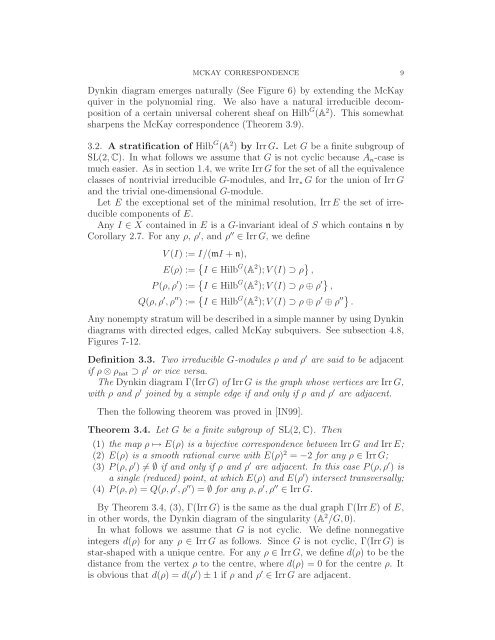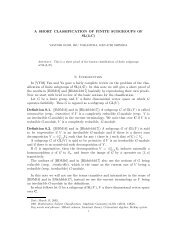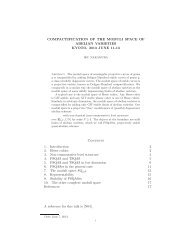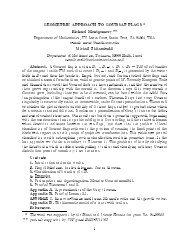mckay correspondence iku nakamura
mckay correspondence iku nakamura
mckay correspondence iku nakamura
- No tags were found...
Create successful ePaper yourself
Turn your PDF publications into a flip-book with our unique Google optimized e-Paper software.
MCKAY CORRESPONDENCE 9Dynkin diagram emerges naturally (See Figure 6) by extending the McKayquiver in the polynomial ring. We also have a natural irreducible decompositionof a certain universal coherent sheaf on Hilb G (A 2 ). This somewhatsharpens the McKay <strong>correspondence</strong> (Theorem 3.9).3.2. A stratification of Hilb G (A 2 ) by Irr G. Let G be a finite subgroup ofSL(2, C). In what follows we assume that G is not cyclic because A n -case ismuch easier. As in section 1.4, we write Irr G for the set of all the equivalenceclasses of nontrivial irreducible G-modules, and Irr ∗ G for the union of Irr Gand the trivial one-dimensional G-module.Let E the exceptional set of the minimal resolution, Irr E the set of irreduciblecomponents of E.Any I ∈ X contained in E is a G-invariant ideal of S which contains n byCorollary 2.7. For any ρ, ρ ′ , and ρ ′′ ∈ Irr G, we defineV (I) :=I/(mI + n),E(ρ) := { I ∈ Hilb G (A 2 ); V (I) ⊃ ρ } ,P (ρ, ρ ′ ):= { I ∈ Hilb G (A 2 ); V (I) ⊃ ρ ⊕ ρ ′} ,Q(ρ, ρ ′ ,ρ ′′ ):= { I ∈ Hilb G (A 2 ); V (I) ⊃ ρ ⊕ ρ ′ ⊕ ρ ′′} .Any nonempty stratum will be described in a simple manner by using Dynkindiagrams with directed edges, called McKay subquivers. See subsection 4.8,Figures 7-12.Definition 3.3. Two irreducible G-modules ρ and ρ ′ are said to be adjacentif ρ ⊗ ρ nat ⊃ ρ ′ or vice versa.The Dynkin diagram Γ(Irr G) of Irr G is the graph whose vertices are Irr G,with ρ and ρ ′ joined by a simple edge if and only if ρ and ρ ′ are adjacent.Then the following theorem was proved in [IN99].Theorem 3.4. Let G be a finite subgroup of SL(2, C). Then(1) the map ρ ↦→ E(ρ) is a bijective <strong>correspondence</strong> between Irr G and Irr E;(2) E(ρ) is a smooth rational curve with E(ρ) 2 = −2 for any ρ ∈ Irr G;(3) P (ρ, ρ ′ ) ≠ ∅ if and only if ρ and ρ ′ are adjacent. In this case P (ρ, ρ ′ ) isa single (reduced) point, at which E(ρ) and E(ρ ′ ) intersect transversally;(4) P (ρ, ρ) =Q(ρ, ρ ′ ,ρ ′′ )=∅ for any ρ, ρ ′ ,ρ ′′ ∈ Irr G.By Theorem 3.4, (3), Γ(Irr G) is the same as the dual graph Γ(Irr E) ofE,in other words, the Dynkin diagram of the singularity (A 2 /G, 0).In what follows we assume that G is not cyclic. We define nonnegativeintegers d(ρ) for any ρ ∈ Irr G as follows. Since G is not cyclic, Γ(Irr G) isstar-shaped with a unique centre. For any ρ ∈ Irr G, we define d(ρ) to be thedistance from the vertex ρ to the centre, where d(ρ) = 0 for the centre ρ. Itis obvious that d(ρ) =d(ρ ′ ) ± 1ifρ and ρ ′ ∈ Irr G are adjacent.





